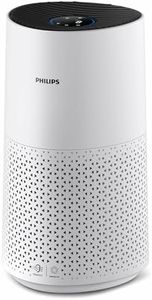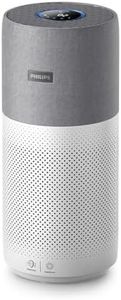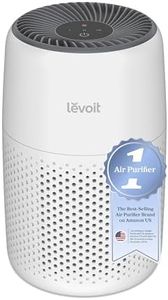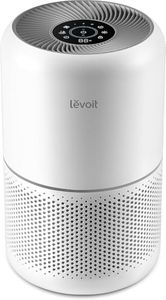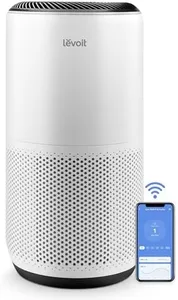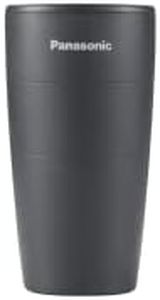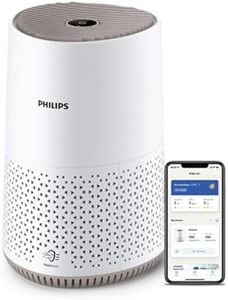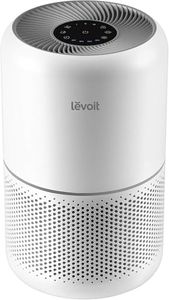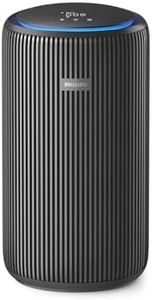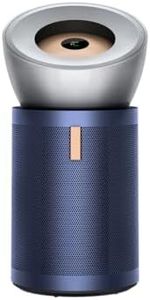We Use CookiesWe use cookies to enhance the security, performance,
functionality and for analytical and promotional activities. By continuing to browse this site you
are agreeing to our privacy policy
10 Best Mold Air Purifiers
From leading brands and best sellers available on the web.Buying Guide for the Best Mold Air Purifiers
Choosing a mold air purifier can make a huge difference in your home's air quality and your overall well-being, especially if you or your family members are sensitive to mold spores. Understanding the key specifications will help you find a purifier that matches your needs, your room size, and your lifestyle, so you can breathe easier and maintain a healthier environment.Filter Type (HEPA, Activated Carbon, UV-C, etc.)The filter type is one of the most important aspects when choosing an air purifier for mold. HEPA filters are highly effective at capturing airborne mold spores and tiny particles, while activated carbon filters help with odors and chemical gases. Some units also offer UV-C light, which can destroy mold and bacteria, providing an additional layer of protection. If you want to tackle mold spores effectively, look for a true HEPA filter. Those who are sensitive to smells or chemicals may benefit from a purifier that also includes activated carbon, while UV-C might be useful for extra biological control. Consider what combination matches your particular situation—if your main concern is allergies to mold, HEPA is essential.
CADR (Clean Air Delivery Rate)CADR stands for Clean Air Delivery Rate and measures how quickly an air purifier can clean the air of certain pollutants like dust, pollen, and smoke. For mold spores, a higher CADR means the unit can filter out spores more quickly and efficiently. CADR scores are usually divided for different particles, but focusing on the dust or pollen rating provides a good indicator for mold. Smaller rooms can be managed with lower CADR (under 100), while medium rooms benefit from CADR scores in the 100-200 range. For large spaces, you'll want a CADR over 200. Picking the right CADR depends on your room size—bigger rooms require higher CADR for effective purification.
Room Coverage (Square Footage)Room coverage tells you how much area the purifier can effectively clean. It's usually given in square feet or meters. If you use a small purifier in a large room, it won't be able to keep up with the air volume, and mold spores may linger. For a small bedroom, look for models rated for up to 150 sq. ft., for living rooms or larger bedrooms, consider models that handle 200-400 sq. ft., and for open spaces or basements, you’ll need purifiers that cover 400 sq. ft. or more. Always match the purifier’s coverage to the largest room you plan to use it in for the best results.
Air Changes per Hour (ACH)Air Changes per Hour (ACH) measures how many times an air purifier can completely filter the air in a room within one hour. For addressing mold, a higher ACH is essential, as it means mold spores are removed quickly and consistently. For mild concerns or generally clean environments, an ACH of 2-3 is usually fine. For allergy sufferers, people with asthma, or those battling visible mold, an ACH of 4-5 or more is ideal. Choose according to the sensitivity of the people using the space and the severity of your mold issue.
Maintenance (Filter Replacement Frequency and Costs)Maintenance involves how often you need to replace the filters and any ongoing costs involved. HEPA filters need changing periodically, and carbon filters may need more frequent replacement if they handle lots of smells. Some purifier models have indicator lights to remind you when it’s time for a filter change. If you prefer less hassle, look for units with longer-lasting filters (sometimes up to a year) or models where filters are easy and mess-free to replace. Consider your willingness to perform regular maintenance and check if replacement filters are easy to find for your chosen purifier.
Noise LevelNoise level indicates how loud the purifier will be during operation, often measured in decibels (dB). Some models can be quiet enough to sleep with, while others may be noticeably loud on higher settings. Lower decibel ratings (below 40 dB) are good for bedrooms and quiet spaces, while noise above 50 dB might be better suited to living rooms or areas where you don’t mind some background hum. Think about where you'll use the purifier the most and whether you need it to be especially quiet, such as for sleeping or working.
